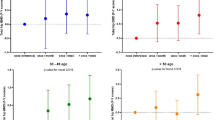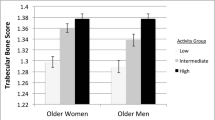Abstract
Girls who exercise athletically have higher bone mass than their sedentary counterparts, and this difference may be sustained in adulthood. However, whether moderate physical activity during youth confers lasting benefits for bone is unclear. We explored lifetime physical activity and current areal bone mineral density (aBMD) in 78 postmenopausal women with no known history of osteoporosis. Subjects reported physical activity for four age periods (12–18, 19–34, 35–49, ≥ 50 years) using the Historical Leisure Activity Questionnaire, completed two 3-day food records, had measurements of height and weight, and aBMD assessed using dual-energy X-ray absorptiometry at the lumbar spine (L1-4) and proximal femora. Low aBMD was detected at the lumbar spine in 43 (56%) women and at the proximal femora in 38 (49%) women. Teenage physical activity, but not activity during other age periods, was associated with current aBMD at both sites (lumbar spine r = 0.31, P < 0.01; mean proximal femora r = 0.33, P < 0.01). Weight-bearing physical activity (WBPA) at age 12–18 years was the only predictor of current lumbar spine aBMD (R 2 = 0.110, P = 0.004). Current proximal femoral aBMD was positively predicted by physical activity at age 12–18 years and negatively predicted by current age (R 2 = 0.175, P = 0.001). Subjects above the median of teen WBPA had 5–8% higher current aBMD than those reporting less teen WBPA and were less likely to be classified with osteopenia or osteoporosis. Moderate physical activity during years of peak bone acquisition appears to have lasting benefits for lumbar spine and proximal femoral aBMD in postmenopausal women.

Similar content being viewed by others
References
Lorrain J, Paiement G, Chevrier N, Lalumiere G, Laflamme GH, Caron P, Fillion A (2003) Population demographics and socioeconomic impact of osteoporotic fractures in Canada. Menopause 10:228–234
Keen RW (2003) Burden of osteoporosis and fractures. Curr Osteoporos Rep 1:66–70
Bonjour J, Theintz G, Buchs B, Slosman D, Rizzoli R (1991) Critical years and stages of puberty for spinal and femoral bone mass accumulation during adolescence. J Clin Endocrinol Metab 73:555–563
Bailey DA, McKay HA, Mirwald RL, Crocker PR, Faulkner RA (1999) A six-year longitudinal study of the relationship of physical activity to bone mineral accrual in growing children: the University of Saskatchewan Bone Mineral Accrual Study. J Bone Miner Res 14:1672–1679
Hernandez CJ, Beaupre GS, Carter DR (2003) A theoretical analysis of the relative influences of peak BMD, age-related bone loss and menopause on the development of osteoporosis. Osteoporos Int 14:843–847
Giguere Y, Rousseau F (2000) The genetics of osteoporosis: complexities and difficulties. Clin Genet 57:161–169
Rizzoli R, Bonjour JP, Ferrari SL (2001) Osteoporosis, genetics and hormones. J Mol Endocrinol 26:79–94
Welten DC, Kemper HC, Post GB, van Mechelen W, Twisk J, Lips P, Teule GJ (1994) Weight-bearing activity during youth is a more important factor for peak bone mass than calcium intake. J Bone Miner Res 9:1089–1096
MacKelvie KJ, Khan KM, Petit MA, Janssen PA, McKay HA (2003) A school-based exercise intervention elicits substantial bone health benefits: a 2-year randomized controlled trial in girls. Pediatrics 112:e447–e452
Snow-Harter C, Bouxsein ML, Lewis BT, Carter DR, Marcus R (1992) Effects of resistance and endurance exercise on bone mineral status of young women: a randomized exercise intervention trial. J Bone Miner Res 7:761–769
Kontulainen SA, Kannus PA, Pasanen ME, Sievanen HT, Heinonen AO, Oja P, Vuori I (2002) Does previous participation in high-impact training result in residual bone gain in growing girls? One year follow-up of a 9-month jumping intervention. Int J Sports Med 23:575–581
Ward KA, Roberts SA, Adams JE, Mughal MZ (2005) Bone geometry and density in the skeleton of pre-pubertal gymnasts and school children. Bone 36:1012–1018
Vicente-Rodriguez G, Dorado C, Perez-Gomez J, Gonzalez-Henriquez JJ, Calbet JA (2004) Enhanced bone mass and physical fitness in young female handball players. Bone 35:1208–1215
Haapasalo H, Kannus P, Sievanen H, Pasanen M, Uusi-Rasi K, Heinonen A, Oja P, Vuori I (1998) Effect of long-term unilateral activity on bone mineral density of female junior tennis players. J Bone Miner Res 13:310–319
Fehling PC, Alekel L, Clasey J, Rector A, Stillman RJ (1995) A comparison of bone mineral densities among female athletes in impact loading and active loading sports. Bone 17:205–210
Heinonen A, Oja P, Kannus P, Sievanen H, Haapasalo H, Manttari A, Vuori I (1995) Bone mineral density in female athletes representing sports with different loading characteristics of the skeleton. Bone 17:197–203
Alfredson H, Nordstrom P, Lorentzon R (1997) Bone mass in female volleyball players: a comparison of total and regional bone mass in female volleyball players and nonactive females. Calcif Tissue Int 60:338–342
Slemenda CW, Johnston CC (1993) High intensity activities in young women: site specific bone mass effects among female figure skaters. Bone Miner 20:125–132
Etherington J, Harris PA, Nandra D, Hart DJ, Wolman RL, Doyle DV, Spector TD (1996) The effect of weight-bearing exercise on bone mineral density: a study of female ex-elite athletes and the general population. J Bone Miner Res 11:1333–1338
Khan KM, Bennell KL, Hopper JL, Flicker L, Nowson CA, Sherwin AJ, Crichton KJ, Harcourt PR, Wark JD (1998) Self-reported ballet classes undertaken at age 10–12 years and hip bone mineral density in later life. Osteoporos Int 8:165–173
Duppe H, Gardsell P, Johnell O, Ornstein E (1996) Bone mineral density in female junior, senior and former football players. Osteoporos Int 6:437–441
Micklesfield L, Rosenberg L, Cooper D, Hoffman M, Kalla A, Stander I, Lambert E (2003) Bone mineral density and lifetime physical activity in South African women. Calcif Tissue Int 73:463–469
Damilakis J, Perisinakis K, Kontakis G, Vagios E, Gourtsoyiannis N (1999) Effect of lifetime occupational physical activity on indices of bone mineral status in healthy postmenopausal women. Calcif Tissue Int 64:112–116
Kriska AM, Sandler RB, Cauley JA, LaPorte RE, Hom DL, Pambianco G (1988) The assessment of historical physical activity and its relation to adult bone parameters. Am J Epidemiol 127:1053–1063
Greendale GA, Barrett-Connor E, Edelstein S, Ingles S, Haile R (1995) Lifetime leisure exercise and osteoporosis. The Rancho Bernardo Study. Am J Epidemiol 141:951–959
Brahm H, Mallmin H, Michaelsson K, Strom H, Ljunghall S (1998) Relationships between bone mass measurements and lifetime physical activity in a Swedish population. Calcif Tissue Int 62:400–412
Kolbe-Alexander TL, Charlton KE, Lambert EV (2004) Lifetime physical activity and determinants of estimated bone mineral density using calcaneal ultrasound in older South African adults. J Nutr Health Aging 8:521–530
Rideout CA, Linden W, Barr SI (2006) High cognitive dietary restraint is associated with increased cortisol excretion in postmenopausal women. J Gerontol A Biol Sci Med Sci 61:628–633
Kriska AM (1997) Historical leisure activity questionnaire. A collection of physical activity questionnaires for health-related research. Med Sci Sports Exerc 29(suppl):43–45
Kriska AM, Knowler WC, LaPorte RE, Drash AL, Wing RR, Blair SN, Bennett PH, Kuller LH (1990) Development of questionnaire to examine relationship of physical activity and diabetes in Pima Indians. Diabetes Care 13:401–411
Winters-Hart CS, Brach JS, Storti KL, Trauth JM, Kriska AM (2004) Validity of a questionnaire to assess historical physical activity in older women. Med Sci Sports Exerc 36:2082–2087
Falkner KL, Trevisan M, McCann SE (1999) Reliability of recall of physical activity in the distant past. Am J Epidemiol 150:195–205
Ryan PJ, Evans P, Blake GM, Fogeman I (1992) The effect of vertebral collapse on spinal bone mineral density measurements in osteoporosis. Bone Miner 18:267–272
Barden HS, Markwardt P, Payne R, Hawkins B, Frank M, Faulkner KG (2003) Automated assessment of exclusion criteria for DXA lumbar spine scans. J Clin Densitom 6:401–410
World Health Organization (1994) Assessment of Fracture Risk and Its Application to Screening for Postmenopausal Osteoporosis. WHO Technical Report Series 843. WHO, Geneva
Siris ES, Miller PD, Barrett-Connor E, Faulkner KG, Wehren LE, Abbott TA, Berger ML, Santora AC, Sherwood LM (2001) Identification and fracture outcomes of undiagnosed low bone mineral density in postmenopausal women: results from the National Osteoporosis Risk Assessment. JAMA 286:2815–2822
Marshall D, Johnell O, Wedel H (1996) Meta-analysis of how well measures of bone mineral density predict occurrence of osteoporotic fractures. BMJ 312:1254–1259
Evenson KR, Wilcox S, Pettinger M, Brunner R, King AC, McTiernan A (2002) Vigorous leisure activity through women’s adult life: the Women’s Health Initiative Observational Cohort Study. Am J Epidemiol 156:945–953
Statistics Canada (2005) Canadian Community Health Survey 2.1 results: leisure-time physical activity, http://www.statcan.ca/english/freepub/82–221-XIE/2005001/nonmed/behaviours3.htm (accessed November 22, 2005)
Ganguli M, Lytle ME, Reynolds MD, Dodge HH (1998) Random versus volunteer selection for a community-based study. J Gerontol A Biol Sci Med Sci 53:M39–M46
Feskanich D, Willett W, Colditz G (2002) Walking and leisure-time activity and risk of hip fracture in postmenopausal women. JAMA 288:2300–2306
Acknowledgment
We thank our research participants for their conscientious involvement in this study and the technicians in Nuclear Medicine at Vancouver General Hospital for their assistance with the DXA measurements. We gratefully acknowledge the funding support of the Canadian Institutes of Health Research (operating grant) and the Michael Smith Foundation for Health Research (trainee award to C. A. R.).
Author information
Authors and Affiliations
Corresponding author
Rights and permissions
About this article
Cite this article
Rideout, C.A., McKay, H.A. & Barr, S.I. Self-Reported Lifetime Physical Activity and Areal Bone Mineral Density in Healthy Postmenopausal Women: The Importance of Teenage Activity. Calcif Tissue Int 79, 214–222 (2006). https://doi.org/10.1007/s00223-006-0058-7
Received:
Accepted:
Published:
Issue Date:
DOI: https://doi.org/10.1007/s00223-006-0058-7




